 SKC Films Library SKC Films Library |
| SKC Films Library >> Science >> Astronomy >> Biography |
| Edmund Halley namesake of a very famous comet
Edmund Halley was born in Haggerstown, England, on November 8, 1656, the son of a prosperous soapmaker and property maker. He was tutored at home before entering St. Paul's School, where he excelled in mathematics and astronomy, and entered Queen's College, Oxford University, in 1673. It was while at Oxford that Halley was introduced, by letter, to Astronomer Royal John Flamsteed, whose catalogue of northern stars inspired Halley to do the same for the Southern Hemisphere. In 1676, with financial assistance from his father and King Charles II, he travelled to the South Atlantic island of St. Helena. By the time he returned home in January 1678 he had recorded the celestial longitudes and latitudes of 341 stars seen only in the Southern Hemisphere, had discovered a star cluster in Centaurus, and had made the first observation of a transit of Mercury across the Sun's disk. During the voyage, he also improved the sextant, and made observations about the ocean and the atmosphere. The star catalogue earned Halley membership in the Royal Society, as well as a Master of Arts degree from Oxford. In 1680, while in Paris, Halley observed a comet. He subsequently worked with Giovanni Cassini to determine its orbit. In 1682 he married Mary Tooke, with whom he had three children. In 1684, Halley, at the behest of Christopher Wren and Robert Hooke, met with Isaac Newton to discuss theories of planetary motions. Newton told him that he had already worked out the mathematics of planetary orbits, but he was unable to produce his calculations as proof. Hooke, who was at the time Newton's biggest rival, was convinced that Newton was lying about having already solved the question of planetary orbits. Halley was certain that Newton was telling the truth, however, and convinced Newton to expand upon and publish his calculations. The result was Philosophiae Naturalis Principia Mathematica, which was published, at Halley's expense, in 1687. While helping Newton with his Principia, Halley was also working on a map of the world showing the distribution of prevailing winds over the oceans. When published in 1686, the map became the first meteorological chart ever published. In 1691, he came up with a diving bell which he and his colleagues tested extensively. In that same year he came up with an early working model of a magnetic compass and introduced it to the Royal Society. His mortality tables for the city of Breslau, Germany (now Wroclaw, Poland), published in 1693, comprised one of the first attempts to relate mortality and age in a population, and, as such, influenced the future development of actuarial tables in the field of life insurance. Under instructions from the Admiralty, he commanded the war sloop Paramore Pink in 1698–1700 on one of the first sea voyages ever undertaken for purely scientific purposes, this one to make measurements of compass declination in the South Atlantic and to determine accurate latitudes and longitudes of the ship's ports of call. In 1701, he published the first magnetic charts of the Atlantic Ocean, and part of the Pacific Ocean, showing curved lines that indicated positions in the oceans having the same compass declination. Halley believed the charts would be useful for navigation by making it possible for sailors to determine longitude while at sea, but it was soon discovered that compass declination can vary from year to year and this method of finding longitude was never widely adopted. In 1704, Halley was appointed Savilian professor of geometry at Oxford University, but he continued his work in astronomy. In 1705, Halley published A Synopsis of the Astronomy of Comets, in which he described the parabolic orbits of 24 comets that had been observed from 1337 to 1698. In the book, he showed that the three historic comets of 1531, 1607, and 1682 were so similar in characteristics that they must have been successive returns of the same object, and that that comet would return in 1758. What is now known as Halley's Comet did indeed return in 1758. In 1716, Halley devised a method for observing transits of Venus across the disk of the sun in order to accurately determine the distance of the Earth from the Sun. In 1720 he succeeded Flamsteed as Astronomer Royal at Greenwich, a position which he held until his death, on January 14, 1742. INTERNET SOURCES SEE ALSO |
| SKC Films Library
>> Science >> Astronomy >> Biography This page was last updated on 05/25/2017. |
